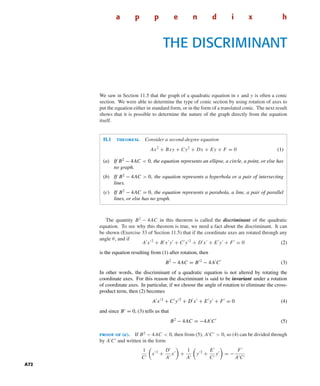
Appendex h
- 1. October 22, 2004 13:27 k34-apph Sheet number 1 Page number 72 cyan magenta yellow black PAGE PROOFS A72 a p p e n d i x h THE DISCRIMINANT We saw in Section 11.5 that the graph of a quadratic equation in x and y is often a conic section. We were able to determine the type of conic section by using rotation of axes to put the equation either in standard form, or in the form of a translated conic. The next result shows that it is possible to determine the nature of the graph directly from the equation itself. H.1 theorem. Consider a second-degree equation Ax2 + Bxy + Cy2 + Dx + Ey + F = 0 (1) (a) If B2 − 4AC < 0, the equation represents an ellipse, a circle, a point, or else has no graph. (b) If B2 − 4AC > 0, the equation represents a hyperbola or a pair of intersecting lines. (c) If B2 − 4AC = 0, the equation represents a parabola, a line, a pair of parallel lines, or else has no graph. The quantity B2 − 4AC in this theorem is called the discriminant of the quadratic equation. To see why this theorem is true, we need a fact about the discriminant. It can be shown (Exercise 33 of Section 11.5) that if the coordinate axes are rotated through any angle θ, and if A x 2 + B x y + C y 2 + D x + E y + F = 0 (2) is the equation resulting from (1) after rotation, then B2 − 4AC = B 2 − 4A C (3) In other words, the discriminant of a quadratic equation is not altered by rotating the coordinate axes. For this reason the discriminant is said to be invariant under a rotation of coordinate axes. In particular, if we choose the angle of rotation to eliminate the cross- product term, then (2) becomes A x 2 + C y 2 + D x + E y + F = 0 (4) and since B = 0, (3) tells us that B2 − 4AC = −4A C (5) proof of (a). If B2 − 4AC < 0, then from (5), A C > 0, so (4) can be divided through by A C and written in the form 1 C x 2 + D A x + 1 A y 2 + E C y = − F A C
- 2. October 22, 2004 13:27 k34-apph Sheet number 2 Page number 73 cyan magenta yellow black PAGE PROOFS Appendix H: The Discriminant A73 Since A C > 0, the numbers A and C have the same sign. We assume that this sign is positive, since Equation (4) can be multiplied through by −1 to achieve this, if necessary. By completing the squares, we can rewrite the last equation in the form (x − h)2 ( √ C )2 + (y − k)2 ( √ A )2 = K There are three possibilities: K > 0, in which case the graph is either a circle or an ellipse, depending on whether or not the denominators are equal; K < 0, in which case there is no graph, since the left side is nonnegative for all x and y ; or K = 0, in which case the graph is the single point (h, k), since the equation is satisfied only by x = h and y = k. The proofs of parts (b) and (c) require a similar kind of analysis. I Example 1 Use the discriminant to identify the graph of 8x2 − 3xy + 5y2 − 7x + 6 = 0 Solution. We have B2 − 4AC = (−3)2 − 4(8)(5) = −151 Since the discriminant is negative, the equation represents an ellipse, a point, or else has no graph. (Why can’t the graph be a circle?) In cases where a quadratic equation represents a point, a line, a pair of parallel lines, a pair of intersecting lines, or has no graph, we say that equation represents a degenerate conic section. Thus, if we allow for possible degeneracy, it follows from Theorem H.1 that every quadratic equation has a conic section as its graph. EXERCISE SET H C CAS 1–5 Use the discriminant to identify the graph of the given equation. 1. x2 − xy + y2 − 2 = 0 2. x2 + 4xy − 2y2 − 6 = 0 3. x2 + 2 √ 3xy + 3y2 + 2 √ 3x − 2y = 0 4. 6x2 + 24xy − y2 − 12x + 26y + 11 = 0 5. 34x2 − 24xy + 41y2 − 25 = 0 6. Each of the following represents a degenerate conic section. Where possible, sketch the graph. (a) x2 − y2 = 0 (b) x2 + 3y2 + 7 = 0 (c) 8x2 + 7y2 = 0 (d) x2 − 2xy + y2 = 0 (e) 9x2 + 12xy + 4y2 − 36 = 0 (f ) x2 + y2 − 2x − 4y = −5 7. Prove parts (b) and (c) of Theorem H.1. 8.C Consider the conic whose equation is x2 + xy + 2y2 − x + 3y + 1 = 0 (a) Use the discriminant to identify the conic. (b) Graph the equation by solving for y in terms of x and graphing both solutions. (c) Your CAS may be able to graph the equation in the form given. If so, graph the equation in this way. 9.C Consider the conic whose equation is 2x2 + 9xy + y2 − 6x + y − 4 = 0 (a) Use the discriminant to identify the conic. (b) Graph the equation by solving for y in terms of x and graphing both solutions. (c) Your CAS may be able to graph the equation in the form given. If so, graph the equation in this way.